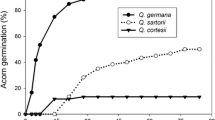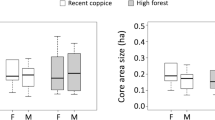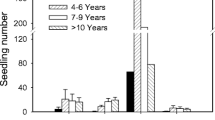Abstract
Quercus suber, Quercus ilex and Quercus coccifera (Cork, Holm and Kermes oaks, respectively) are common evergreen oak species that coexist in the landscapes of the western part of the Mediterranean basin. Rodents are the main acorn predators and thus one of the main factors for understanding recruitment patterns in oaks. In this paper we analyse to what extent mice prefer acorns from one oak species over another in three oak species studied using acorn removal experiments and video tape recordings. Twenty labelled acorns from each of the three Quercus species (60 acorns) were placed in 40 cm×40 cm quadrats on each plot. Because selection might vary as a result of the vegetation context, we performed the trials in the five main vegetation types within the study area (four replicates in each vegetation type) in order to control for habitat influences on rodent acorn preferences (a total of 20 plots). The removal of 1,200 acorns occurred within 68 days. Mice removed 98.7% of the acorns. Q. ilex acorns were preferred over Q. suber and Q. coccifera in all vegetation types except in pine forest, where no acorn preferences were detected. Acorn removal rates differed with vegetation type, correlating positively with shrub cover. The distance at which acorns were displaced by rodents (mean =4.6 m±5.1 SD) did not differ between acorn species, but varied among vegetation types. Bigger acorns of Q. coccifera were selected only after Q. ilex and Q. suber acorns were depleted, while no size selection was detected for the latter two species. Thus, we conclude that rodents show preference for some oak acorns and that landscape context contributes significantly to rodent activities and decisions.

Similar content being viewed by others
References
Afzalrafii Z, Dodd RS, Pelleau Y (1992) Mediterranean evergreen oak diversity—morphological and chemical variation of acorns. Can J Bot 70:1459–1466
Alcantara JM (2000) Factors shaping the seedfall pattern of a bird-dispersed plant. Ecology 81:1937–1950
Bonet A, Pausas JG (2006) Old field dynamics on the dry side of the Mediterranean basin: patterns and processes in semiarid SE Spain. In: Cramer VA, Hobbs RJ (eds) Old fields: dynamics and restoration of abandoned farmland. Island Press (in press)
Borchert M (1989) Interaction of factors affecting seedling recruitment of blue oak (Quercus douglasii) in California. Ecology 70:389–404
Briggs JM, Smith KG (1989) Influence of habitat on acorn selection by Peromyscus leucopus. J Mammal 70:35–43
Cañellas I, San Miguel A (2003) La coscoja (Quercus coccifera L.): ecología, características y usos. Monografías. INIA, Madrid
Cantos E, Espin JC, Lopez-Bote C, De la Hoz L, Ordonez JA, Tomas-Barberan FA (2003) Phenolic compounds and fatty acids from acorns (Quercus spp.), the main dietary constituent of free-ranged Iberian pigs. J Agric Food Chem 51:6248–6255
Díaz M, Torre I, Peris A, Tena L (2005) Foraging behaviour of wood mice as related to presence and activity of genets. J Mammal 86:165–172
Falkenberg JC, Clarke JA (1998) Microhabitat use of deer mice: effects of interspecific interaction risk. J Mammal 79:558–565
Ferreira-Dias S, Valente DG, Abreu JMF (2003) Pattern recognition of acorns from different Quercus species based on oil content and fatty acid profile. Grasas y Aceites 54:384–391
Gomez JM (2004a) Bigger is not always better: conflicting selective pressures on seed size in Quercus ilex. Evolution 58:71–80
Gomez JM (2004b) Importance of microhabitat and acorn burial on Quercus ilex early recruitment: non-additive effects on multiple demographic processes. Plant Ecol 172:287–297
Gomez JM, Garcia D, Zamora R (2003) Impact of vertebrate acorn- and seedling-predators on a Mediterranean Quercus pyrenaica forest. For Ecol Manage 180:125–134
Hoshizaki K, Hulme PE (2002) Mast seeding and predator-mediated indirect interactions in a forest community: evidence from post-dispersal fate of rodent-generated caches. In: Seed dispersal and frugivory. CAB International, UK, pp 227–239
Hulme PE (1994) Post dispersal seed predation in grassland: its magnitude and sources of variation. J Ecol 82:645–652
Hulme PE (1997) Post-dispersal seed predation and the establishment of vertebrate dispersed plants in Mediterranean scrublands. Oecologia 111:91–98
Ivan JS, Swihart RK (2000) Selection of mast by granivorous rodents of the central hardwood forest region. J Mammal 81:549–562
Janzen DH (1971) Seed predation by animals. Annu Rev Ecol Syst 2:465–492
Jensen TS (1985) Seed–seed predator interactions of European beech (Fagus silvatica) and forest rodents, Clethrionomys glareolus and Apodemus flavicollis. Oikos 44:149–156
Kollmann J (1995) Regeneration window for fleshy-fruited plants during scrub development on abandoned grassland. Ecoscience 2:213–222
Liebhold A, Sork V, Peltonen M, Koenig W, Bjornstad ON, Westfall R, Elkinton J, Knops JMH (2004) Within-population spatial synchrony in mast seeding of North American oaks. Oikos 104:156–164
Manson RH, Stiles EW (1998) Links between microhabitat preferences and seed predation by small mammals in old fields. Oikos 82:37–50
McShea WJ (2000) The influence of acorn crops on annual variation in rodent and bird populations. Ecology 81:228–238
Mohler CL (1990) Co-occurrence of oak subgenera: implications for niche differentiation. Bull Torrey Bot Club 117:247–255
Muenchow G (1986) Ecological use of time failure analysis. Ecology 67:246–250
Nieto R, Rivera M, Garcia MA, Aguilera JF (2002) Amino acid availability and energy value of acorn in the Iberian pig. Livest Prod Sci 77:227–239
Ostfeld RS, Jones CG, Wolff JO (1996) Of mice and mast. Bioscience 46:323–330
Ostfeld RS, Manson RH, Canham CD (1997) Effects of rodents on survival of tree seeds and seedlings invading old fields. Ecology 78:1531–1542
Pausas JG (2004) Changes in fire and climate in the eastern Iberian Peninsula (Mediterranean basin). Clim Change 63:337–350
Pausas JG, Blade C, Valdecantos A, Seva JP, Fuentes D, Alloza JA, Vilagrosa A, Bautista S, Cortina J, Vallejo R (2004) Pines and oaks in the restoration of Mediterranean landscapes of Spain: new perspectives for an old practice—a review. Plant Ecol 171:209–220
Pons J, Pausas JG (2006) Oak regeneration in heterogeneous landscapes: the case of fragmented Quercus suber forests in the eastern Iberian Peninsula. For Ecol Manage 231:196–204
Pulido FJ, Díaz M (2005) Regeneration of a Mediterranean oak: a whole-cycle approach. Ecoscience 12:92–102
Pyke DA (1986) Statistical analysis of survival and removal rates experiments. Ecology 67:240–245
Scarlett TL, Smith G (1991) Acorn preference of urban Blue Jays (Cyanocitta cristata) during fall and spring in north-eastern Arkansas. Condor 93:438–442
Shaw MW (1968) Factors affecting the natural regeneration of Sessile oak (Q. petraea) in North Wales: acorn losses and germination under field conditions. J Ecol 56:647–659
Shimada T (2001a) Hoarding behaviors of two wood mouse species: different preference for acorns of two Fagaceae species. Ecol Res 16:127–133
Shimada T (2001b) Nutrient compositions of acorns and horse chestnuts in relation to seed-hoarding. Ecol Res 16:803–808
Sone K, Kohno A (1996) Application of radiotelemetry to the survey of acorn dispersal by Apodemus mice. Ecol Res 11:187–192
Stapanian MA, Smith CC (1978) A model for seed scatterhoarding: coevolution of fox squirrels and black walnuts. Ecology 59:884–896
Talebbendiab SA, Benmahdi M, Mashev NP, Vassilev GN (1990) Contribution to the investigation of the chemical composition of the acorn of various Quercus species in Algeria—investigating the acorn of Quercus ilex. Dokl Bolg Akad Nauk 43:83–86
Talebbendiab SA, Benmahdi M, Mashev N, Vassilev GN (1991) A tribute to the study of the chemical composition of the acorn of different species of Quercus spread in Algeria. Dokl Bolg Akad Nauk 44:85–88
Torre I, Díaz M (2004) Small mammal abundance in Mediterranean post-fire habitats: a role for predators? Acta Oecol 25:137–142
Vander Wall SB (2002) Masting in animal-dispersed pines facilitates seed dispersal. Ecology 83:3508–3516
Willson MF, Whelan CJ (1990) Variation in postdispersal survival of vertebrate dispersed seed: effects of density, habitat, location, season and species. Oikos 57:191–198
Xiao ZS, Zhang ZB, Wang YS (2004) Dispersal and germination of big and small nuts of Quercus serrata in a subtropical broad-leaved evergreen forest. For Ecol Manage 195:141–150
Acknowledgments
This work has been financed by the EU project CREOAK (QLRT-2001-01594) and the Spanish project VARQUS (CGL2004-04325/BOS). T. Rodrigues and P. Azeiteiro helped with the field work under an EU Leonardo da Vinci fellowship. We thank M. Díaz, A. Muñoz and J. Belliure for their kind review of the first draft of this paper. CEAM is funded by Generalitat Valenciana and Bancaixa.
Author information
Authors and Affiliations
Corresponding author
About this article
Cite this article
Pons, J., Pausas, J.G. Rodent acorn selection in a Mediterranean oak landscape. Ecol Res 22, 535–541 (2007). https://doi.org/10.1007/s11284-006-0053-5
Received:
Accepted:
Published:
Issue Date:
DOI: https://doi.org/10.1007/s11284-006-0053-5




